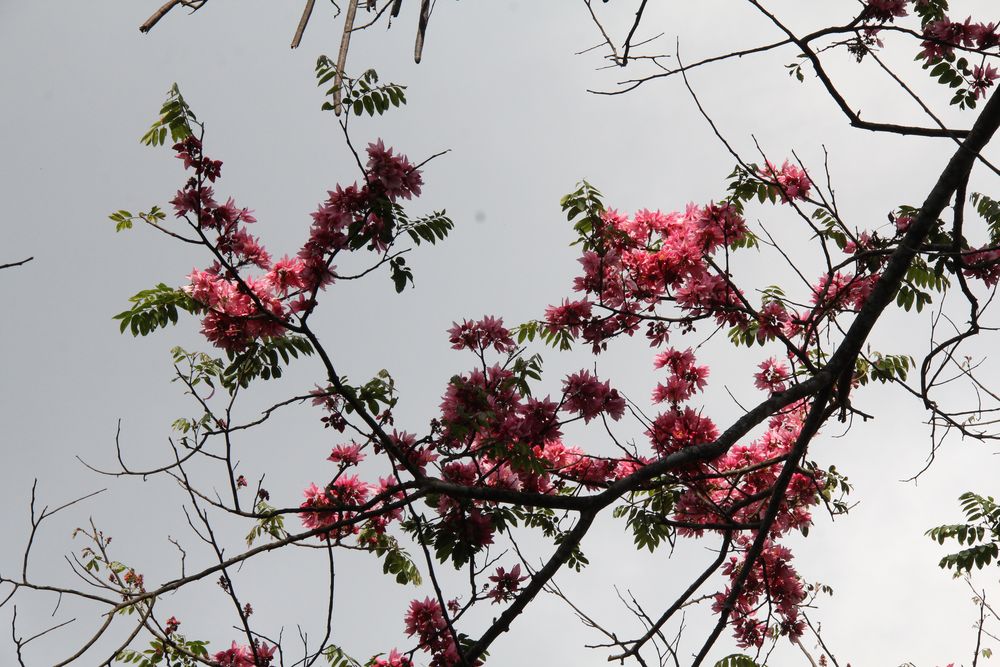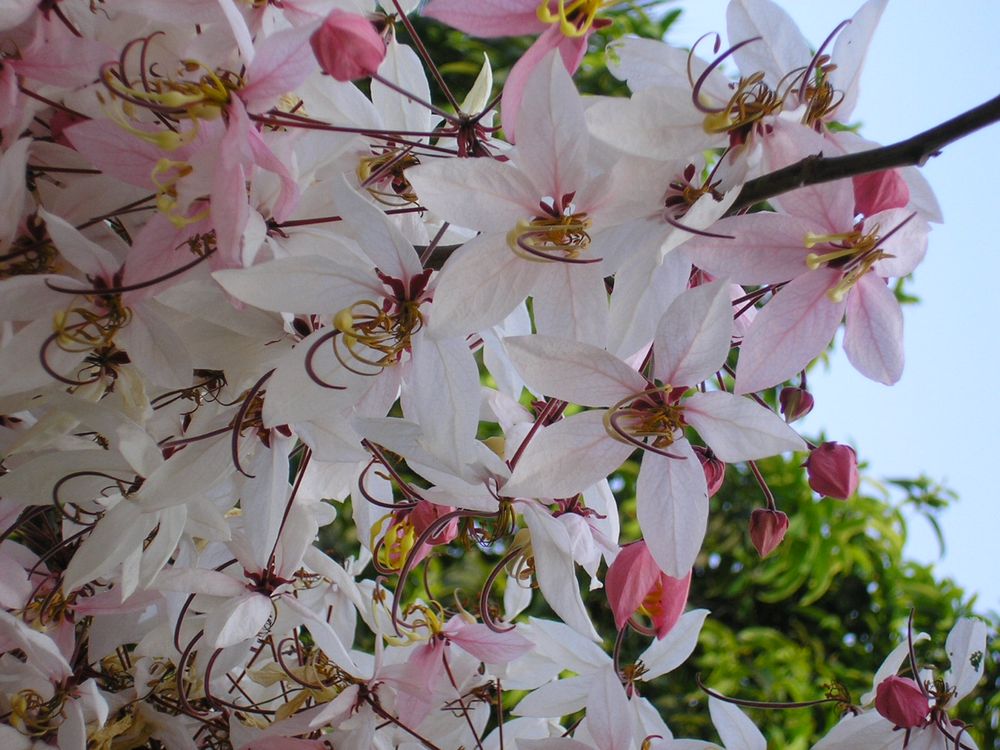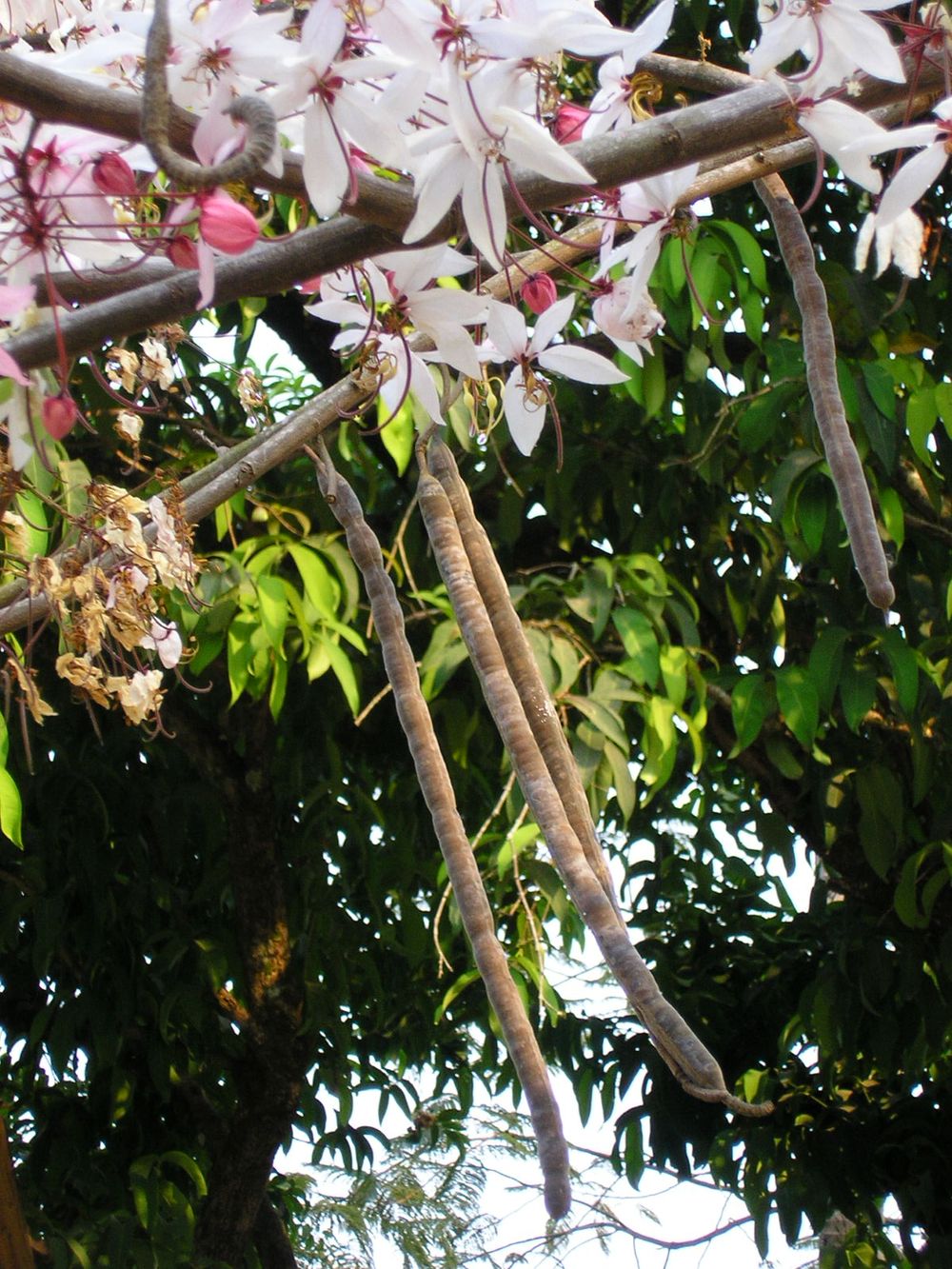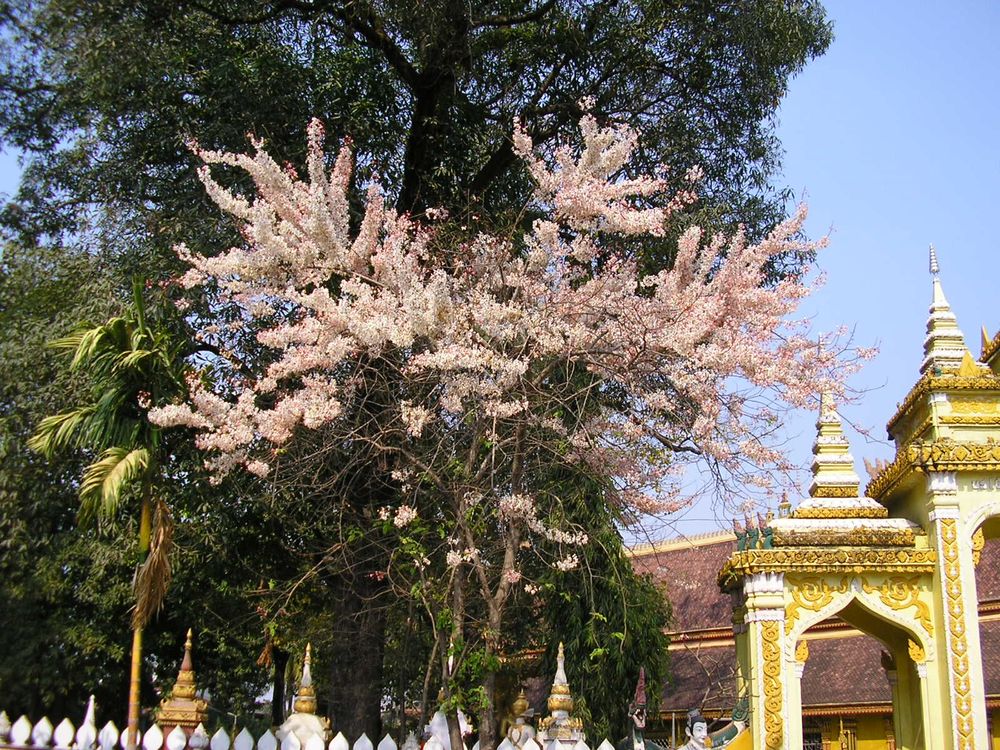The particularity of this file is that we have not found a Lao name for this beautiful tree, yet native to the region and more particularly, think botanists, from Thailand.
The cassia genus is one of the most important in the plant kingdom; we know well at least two of them: dok khoun (Cassia fistula) and phak khi lèk (Cassia siamea) which have yellow flowers; Cassia bekeriana has pinkish-white flowers which lead to the English name Pink Shower Tree, in the same way that Cassia fistula is Golden Shower Tree.
Cassia bakeriana is a tree of about ten meters with a tormented port; its leaves are pinnate with oval leaflets of 5 to 7 pairs; the young leaves are covered with a brown down. The flowers that appear at the end of the dry season, before the leaves, mask the branches with their pink inflorescences; the flower bud is dark pink and the petals are almost white surrounding yellow stamens. The pod is cylindrical and elongated, also covered with a brown down.
This tree which grows naturally in Thai forests is cultivated as an ornamental plant but not only. Indeed, like Cassia fistula, Cassia bakeriana is a good laxative for children: scrape the pulp that surrounds the seeds in the pod and mix it with a drink; in French “la casse” is this laxative pulp. If in Thailand this medicinal use is known, the tree is mainly cultivated for its symbolic value because the Thais are not far from considering it as the tree par excellence and would like to make it the national tree. It is already the emblem of several Thai provinces (Khon Kaen).
Its symbolic value this Cassia owes in part to the fact that it is often reinterpreted in Thailand as being a “Kappa tree”, Kalapheuk, a paradise tree in Buddhist mythology which produces everything one could desire. Louis Gabaude thus develops the different metaphors that build this tree: “The trunk of the Kappa tree sometimes designates the ten parami (perfection), because, like it, they make it possible to obtain what one wants. The flowers denote the important renunciations of giving up one’s wife, children, wealth, limbs, and life. The fruits designate Enlightenment, the perfect knowledge acquired by the Buddha ». However, we have already mentioned this mythical tree in connection with Couroupita Gianensis, also reinterpreted by some Laos as a Kalapheuk, and planted at Wat Simuang in Vientiane. It is also in this same vat that one can admire, at the end of the dry season, the very beautiful pink flowering of Cassia bakeriana.
La particularité de cette fiche c’est que nous n’avons pas trouvé de nom lao pour ce bel arbre pourtant originaire de la région et plus particulièrement, pensent les botanistes, de Thaïlande.
Le genre cassia est l’un des plus importants du règne végétal; nous en connaissons bien au moins deux: dok khoun (Cassia fistula) et phak khi lèk (Cassia siamea) qui ont des fleurs jaunes; Cassia bekeriana a lui des fleurs blanc rosé qui induisent en anglais le nom Pink Shower Tree, de la même façon que Cassia fistula est Golden Shower Tree.
Cassia bakeriana est un arbre d’une dizaine de mètres au port tourmenté; ses feuilles sont pennées avec des folioles ovales de 5 à 7 paires; les jeunes feuilles sont recouvertes d’un duvet brun. Les fleurs qui apparaissent en fin de saison sèche, avant les feuilles, masquent les rameaux de leurs inflorescences roses; le bouton floral est rose foncé et les pétales sont presque blancs entourant des étamines jaunes. La gousse est cylindrique et allongée recouverte elle aussi d’un duvet brun.
Cet arbre qui pousse naturellement dans les forêts thaïlandaises est cultivé comme plante ornementale mais pas seulement. En effet comme le Cassia fistula, Cassia bakeriana est un bon laxatif pour les enfants: on racle la pulpe qui entoure les graines dans la gousse et on la mélange à une boisson; en français « la casse » est cette pulpe laxative. Si en Thaïlande cet usage médicinal est connu, l’arbre est surtout cultivé pour sa valeur symbolique car les Thaïs ne sont pas loin de le considérer comme l’arbre par excellence et voudraient en faire l’arbre national. Il est d’ailleurs déjà l’emblème de plusieurs provinces thaïlandaises (Khon Kaen).
Sa valeur symbolique ce Cassia la doit en partie au fait qu’il est souvent réinterprété en Thaïlande comme étant un « arbre du Kappa », Kalapheuk, arbre paradisiaque de la mythologie bouddhique qui produit tout ce que l’on peut désirer. Louis Gabaude développe ainsi les différentes métaphores qui construisent cet arbre: «Le tronc de l’arbre du Kappa désigne parfois les dix parami (perfection), car, comme lui, elles permettent d’obtenir ce que l’on veut. Les fleurs désignent les renonciations importantes qui consistent à donner sa femme, ses enfants, ses richesses, ses membres et sa vie. Les fruits désignent l’Eveil, la parfaite connaissance acquise par le Bouddha ». Or nous avons déjà évoqué cet arbre mythique à propos de Couroupita Gianensis, lui aussi réinterprété par certains Lao comme un Kalapheuk, et planté au vat Simuang à Vientiane. C’est d’ailleurs dans ce même vat que l’on peut admirer, en fin de saison sèche, la très belle floraison rose de Cassia bakeriana.




The particularity of this file is that we have not found a Lao name for this beautiful tree, yet native to the region and more particularly, think botanists, from Thailand.
The cassia genus is one of the most important in the plant kingdom; we know well at least two of them: dok khoun (Cassia fistula) and phak khi lèk (Cassia siamea) which have yellow flowers; Cassia bekeriana has pinkish-white flowers which lead to the English name Pink Shower Tree, in the same way that Cassia fistula is Golden Shower Tree.
Cassia bakeriana is a tree of about ten meters with a tormented port; its leaves are pinnate with oval leaflets of 5 to 7 pairs; the young leaves are covered with a brown down. The flowers that appear at the end of the dry season, before the leaves, mask the branches with their pink inflorescences; the flower bud is dark pink and the petals are almost white surrounding yellow stamens. The pod is cylindrical and elongated, also covered with a brown down.
This tree which grows naturally in Thai forests is cultivated as an ornamental plant but not only. Indeed, like Cassia fistula, Cassia bakeriana is a good laxative for children: scrape the pulp that surrounds the seeds in the pod and mix it with a drink; in French “la casse” is this laxative pulp. If in Thailand this medicinal use is known, the tree is mainly cultivated for its symbolic value because the Thais are not far from considering it as the tree par excellence and would like to make it the national tree. It is already the emblem of several Thai provinces (Khon Kaen).
Its symbolic value this Cassia owes in part to the fact that it is often reinterpreted in Thailand as being a “Kappa tree”, Kalapheuk, a paradise tree in Buddhist mythology which produces everything one could desire. Louis Gabaude thus develops the different metaphors that build this tree: “The trunk of the Kappa tree sometimes designates the ten parami (perfection), because, like it, they make it possible to obtain what one wants. The flowers denote the important renunciations of giving up one’s wife, children, wealth, limbs, and life. The fruits designate Enlightenment, the perfect knowledge acquired by the Buddha ». However, we have already mentioned this mythical tree in connection with Couroupita Gianensis, also reinterpreted by some Laos as a Kalapheuk, and planted at Wat Simuang in Vientiane. It is also in this same vat that one can admire, at the end of the dry season, the very beautiful pink flowering of Cassia bakeriana.
La particularité de cette fiche c’est que nous n’avons pas trouvé de nom lao pour ce bel arbre pourtant originaire de la région et plus particulièrement, pensent les botanistes, de Thaïlande.
Le genre cassia est l’un des plus importants du règne végétal; nous en connaissons bien au moins deux: dok khoun (Cassia fistula) et phak khi lèk (Cassia siamea) qui ont des fleurs jaunes; Cassia bekeriana a lui des fleurs blanc rosé qui induisent en anglais le nom Pink Shower Tree, de la même façon que Cassia fistula est Golden Shower Tree.
Cassia bakeriana est un arbre d’une dizaine de mètres au port tourmenté; ses feuilles sont pennées avec des folioles ovales de 5 à 7 paires; les jeunes feuilles sont recouvertes d’un duvet brun. Les fleurs qui apparaissent en fin de saison sèche, avant les feuilles, masquent les rameaux de leurs inflorescences roses; le bouton floral est rose foncé et les pétales sont presque blancs entourant des étamines jaunes. La gousse est cylindrique et allongée recouverte elle aussi d’un duvet brun.
Cet arbre qui pousse naturellement dans les forêts thaïlandaises est cultivé comme plante ornementale mais pas seulement. En effet comme le Cassia fistula, Cassia bakeriana est un bon laxatif pour les enfants: on racle la pulpe qui entoure les graines dans la gousse et on la mélange à une boisson; en français « la casse » est cette pulpe laxative. Si en Thaïlande cet usage médicinal est connu, l’arbre est surtout cultivé pour sa valeur symbolique car les Thaïs ne sont pas loin de le considérer comme l’arbre par excellence et voudraient en faire l’arbre national. Il est d’ailleurs déjà l’emblème de plusieurs provinces thaïlandaises (Khon Kaen).
Sa valeur symbolique ce Cassia la doit en partie au fait qu’il est souvent réinterprété en Thaïlande comme étant un « arbre du Kappa », Kalapheuk, arbre paradisiaque de la mythologie bouddhique qui produit tout ce que l’on peut désirer. Louis Gabaude développe ainsi les différentes métaphores qui construisent cet arbre: «Le tronc de l’arbre du Kappa désigne parfois les dix parami (perfection), car, comme lui, elles permettent d’obtenir ce que l’on veut. Les fleurs désignent les renonciations importantes qui consistent à donner sa femme, ses enfants, ses richesses, ses membres et sa vie. Les fruits désignent l’Eveil, la parfaite connaissance acquise par le Bouddha ». Or nous avons déjà évoqué cet arbre mythique à propos de Couroupita Gianensis, lui aussi réinterprété par certains Lao comme un Kalapheuk, et planté au vat Simuang à Vientiane. C’est d’ailleurs dans ce même vat que l’on peut admirer, en fin de saison sèche, la très belle floraison rose de Cassia bakeriana.








The particularity of this file is that we have not found a Lao name for this beautiful tree, yet native to the region and more particularly, think botanists, from Thailand.
The cassia genus is one of the most important in the plant kingdom; we know well at least two of them: dok khoun (Cassia fistula) and phak khi lèk (Cassia siamea) which have yellow flowers; Cassia bekeriana has pinkish-white flowers which lead to the English name Pink Shower Tree, in the same way that Cassia fistula is Golden Shower Tree.
Cassia bakeriana is a tree of about ten meters with a tormented port; its leaves are pinnate with oval leaflets of 5 to 7 pairs; the young leaves are covered with a brown down. The flowers that appear at the end of the dry season, before the leaves, mask the branches with their pink inflorescences; the flower bud is dark pink and the petals are almost white surrounding yellow stamens. The pod is cylindrical and elongated, also covered with a brown down.
This tree which grows naturally in Thai forests is cultivated as an ornamental plant but not only. Indeed, like Cassia fistula, Cassia bakeriana is a good laxative for children: scrape the pulp that surrounds the seeds in the pod and mix it with a drink; in French “la casse” is this laxative pulp. If in Thailand this medicinal use is known, the tree is mainly cultivated for its symbolic value because the Thais are not far from considering it as the tree par excellence and would like to make it the national tree. It is already the emblem of several Thai provinces (Khon Kaen).
Its symbolic value this Cassia owes in part to the fact that it is often reinterpreted in Thailand as being a “Kappa tree”, Kalapheuk, a paradise tree in Buddhist mythology which produces everything one could desire. Louis Gabaude thus develops the different metaphors that build this tree: “The trunk of the Kappa tree sometimes designates the ten parami (perfection), because, like it, they make it possible to obtain what one wants. The flowers denote the important renunciations of giving up one’s wife, children, wealth, limbs, and life. The fruits designate Enlightenment, the perfect knowledge acquired by the Buddha ». However, we have already mentioned this mythical tree in connection with Couroupita Gianensis, also reinterpreted by some Laos as a Kalapheuk, and planted at Wat Simuang in Vientiane. It is also in this same vat that one can admire, at the end of the dry season, the very beautiful pink flowering of Cassia bakeriana.
La particularité de cette fiche c’est que nous n’avons pas trouvé de nom lao pour ce bel arbre pourtant originaire de la région et plus particulièrement, pensent les botanistes, de Thaïlande.
Le genre cassia est l’un des plus importants du règne végétal; nous en connaissons bien au moins deux: dok khoun (Cassia fistula) et phak khi lèk (Cassia siamea) qui ont des fleurs jaunes; Cassia bekeriana a lui des fleurs blanc rosé qui induisent en anglais le nom Pink Shower Tree, de la même façon que Cassia fistula est Golden Shower Tree.
Cassia bakeriana est un arbre d’une dizaine de mètres au port tourmenté; ses feuilles sont pennées avec des folioles ovales de 5 à 7 paires; les jeunes feuilles sont recouvertes d’un duvet brun. Les fleurs qui apparaissent en fin de saison sèche, avant les feuilles, masquent les rameaux de leurs inflorescences roses; le bouton floral est rose foncé et les pétales sont presque blancs entourant des étamines jaunes. La gousse est cylindrique et allongée recouverte elle aussi d’un duvet brun.
Cet arbre qui pousse naturellement dans les forêts thaïlandaises est cultivé comme plante ornementale mais pas seulement. En effet comme le Cassia fistula, Cassia bakeriana est un bon laxatif pour les enfants: on racle la pulpe qui entoure les graines dans la gousse et on la mélange à une boisson; en français « la casse » est cette pulpe laxative. Si en Thaïlande cet usage médicinal est connu, l’arbre est surtout cultivé pour sa valeur symbolique car les Thaïs ne sont pas loin de le considérer comme l’arbre par excellence et voudraient en faire l’arbre national. Il est d’ailleurs déjà l’emblème de plusieurs provinces thaïlandaises (Khon Kaen).
Sa valeur symbolique ce Cassia la doit en partie au fait qu’il est souvent réinterprété en Thaïlande comme étant un « arbre du Kappa », Kalapheuk, arbre paradisiaque de la mythologie bouddhique qui produit tout ce que l’on peut désirer. Louis Gabaude développe ainsi les différentes métaphores qui construisent cet arbre: «Le tronc de l’arbre du Kappa désigne parfois les dix parami (perfection), car, comme lui, elles permettent d’obtenir ce que l’on veut. Les fleurs désignent les renonciations importantes qui consistent à donner sa femme, ses enfants, ses richesses, ses membres et sa vie. Les fruits désignent l’Eveil, la parfaite connaissance acquise par le Bouddha ». Or nous avons déjà évoqué cet arbre mythique à propos de Couroupita Gianensis, lui aussi réinterprété par certains Lao comme un Kalapheuk, et planté au vat Simuang à Vientiane. C’est d’ailleurs dans ce même vat que l’on peut admirer, en fin de saison sèche, la très belle floraison rose de Cassia bakeriana.


